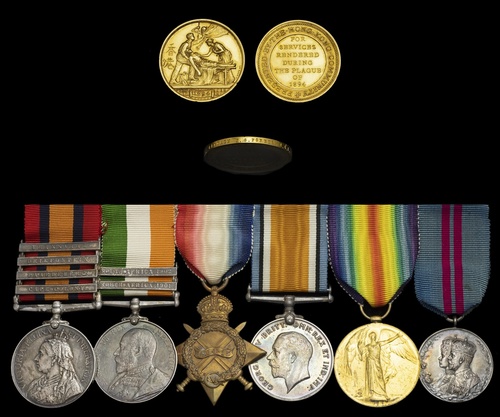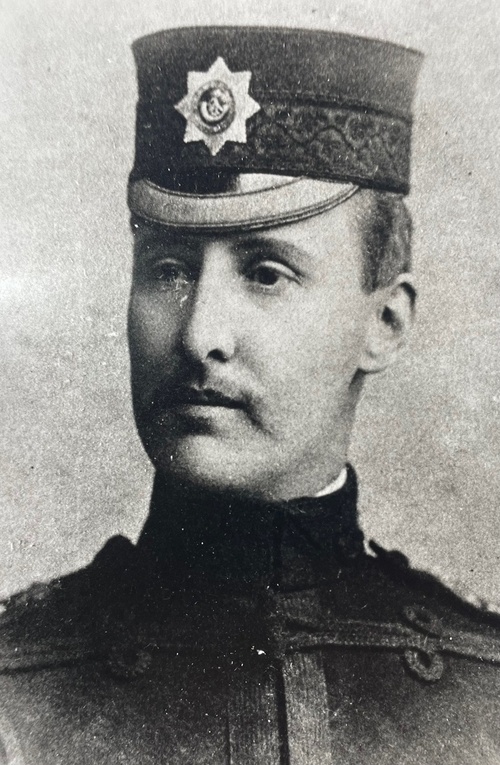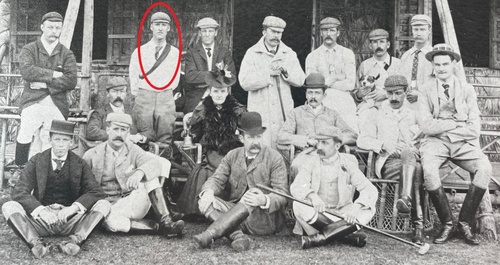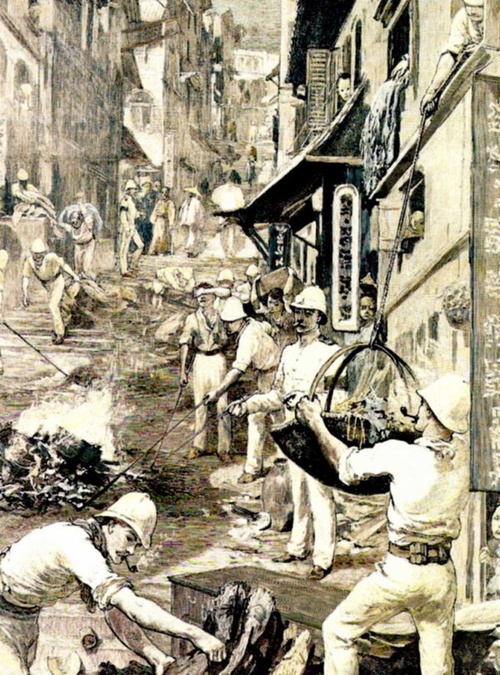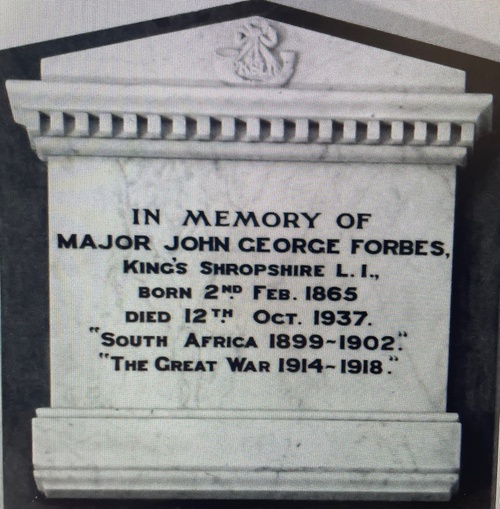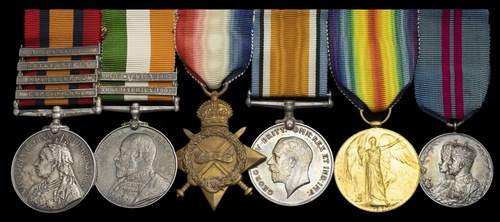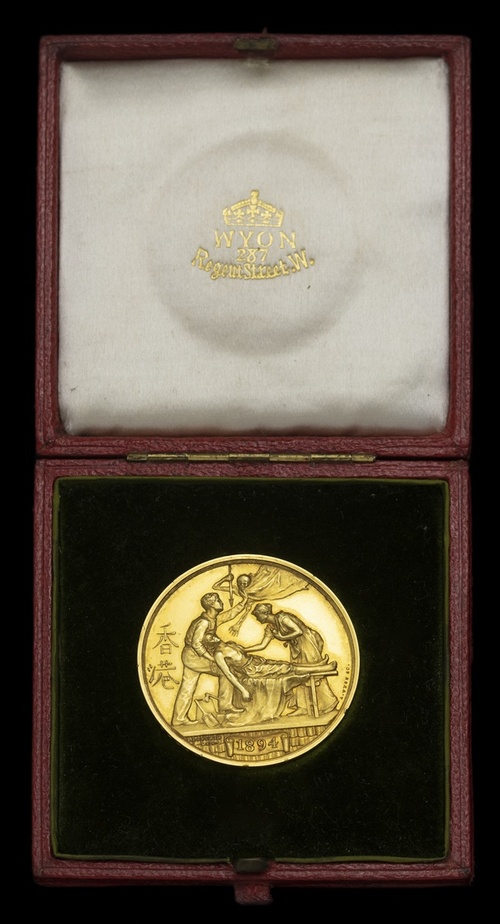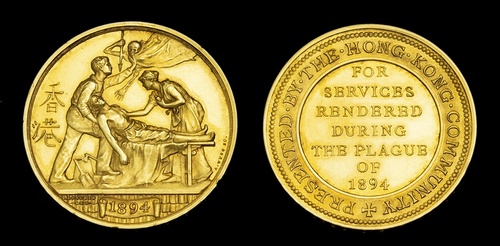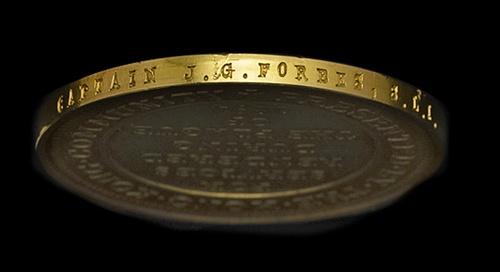Auction: 25001 - Orders, Decorations and Medals
Lot: 66
(x) The campaign group of seven awarded to Major J. G. Forbes, King's Shropshire Light Infantry, who took the Hong Kong Plague Medal in gold when forming part of 'The Whitewash Brigade', being called out against the 'Black Death' during 1894; Forbes was no stranger to the risks posed by this deadly disease and acted as pall-bearer to brother officer Captain Vesey, who lost his life to the bubonic plague
Queen's South Africa 1899-1901, 4 clasps, Cape Colony, Paardeberg, Driefontein, Transvaal (Capt. J. G. Forbes. 2/Shrops. L.I.); King's South Africa 1901-02, 2 clasps, South Africa 1901, South Africa 1902 (Capt. J. G. Forbes. Shrop. L.I.); 1914-15 Star (Major J. G. Forbes. Shrops. L.I.); British War and Victory Medals (Major J. G. Forbes.); 1911 Coronation (Major J. G. Forbes), privately engraved naming; Hong Kong Plague 1894, gold issue, unmounted (Captain J. G. Forbes, S.L.I.), in red leather Wyon, Regent St, London case, the first six mounted as worn, good very fine (7)
Provenance:
Spink, September 1963 & August 1986.
John George Forbes was born on 2 February at Melbourne, Victoria, the son of John G. Forbes, a barrister. By 1881 the family were living in Cheltenham, with young Forbes a scholar, likely at Cheltenham College. He then went to the Royal Military Academy Sandhurst and was commissioned into the Shropshire Light Infantry in June 1886. Joining the station at Hong Kong, being a keen horseman, he was a member of the Hong Kong Polo Club by 1893 and Adjutant of his unit.
Whitewash Brigade
A virulent epidemic of bubonic plague broke out in Hong Kong in early May 1894. Recognising the danger, the Governor, Sir William Robinson, K.C.M.G., gathered all the resources available to him, both military and civil, to combat the threat. Special bye-laws were quickly passed and implemented, and temporary plague hospitals were opened. The task of finding, isolating, disinfecting and cleansing infected households was directed by Mr F. H. May, the Captain Superintendent of Police and supervised by Mr J. H. Crook the Sanitary Surveyor. To supplement the local authorities and native labour, Officers and men of the Shropshire Light Infantry and Royal Engineers were drawn in to help with the cleansing operations, and Volunteers for house-to-house visitations were sought amongst the civil population. The population in infected areas were removed and infected houses were rigorously cleansed - floors disinfected, walls, woodwork and furniture thoroughly lime-washed, and bedding, old clothing, old woodwork and general rubbish burnt. Elsewhere, doctors, nurses and ancillary staff worked heroically amongst the sick and dying.
Forbes volunteered and went out on plague duties to relieve other officers as a house-to-house visitor, and doubtless would have followed the official guidelines in helping to combat the spread of the Plague:
'1. Keep separate clothes for working in, which should be changed on returning off duty and kept hung up in the air and sun when not in use.
2. On returning off duty wash the hands in water and Jeyes’ fluid (1 in 20), and if possible take a bath of the same solution.
3. Also rinse the mouth out with Condy’s fluid and water (one teaspoonful to one quart of water).
4. Saturate the handkerchief with Eucalyptus oil when going on duty and apply it frequently to the nose if in an infected house.
5. Smoke.’
Despite all the precautions taken, over 2,500 people, mainly Chinese, contracted the plague, with 2,317 deaths attributed to the disease, a fatality rate of over 90%. That saw a brother officer of the unit, Captain Vesey pass of the plague. Forbes was a pall bearer at his funeral on 5 June when he was buried in the Happy Valley Cemetery.
The plague subsided with the arrival of cold weather, and restrictions were lifted in early September. On 28 September 1894 a public meeting was held at City Hall for the purpose of considering what steps should be taken to recognise the services rendered by the community in combating the plague, and ultimately it was decided that a medal should be awarded, in both gold and silver. His name was one of approximately 13 officers who would take the medal in gold.
He served with the 2nd Battalion during the Boer War in South Africa (Queen's Medal & 4 clasps, King's Medal & 2 clasps) and by 1907 was in command of the Depot Troops at Shrewsbury.
With the outbreak of the Great War, Forbes would see himself proceed overseas as Second-in-Command of the 5th Battalion. They had been formed at Shrewsbury in August 1914 as part of K1 and came under orders of 42nd Brigade in 14th (Light) Division. Moved initially to Aldershot, and then went on to Chiddingfold in March 1915, they landed on 20 May 1915 at Boulogne. Forbes would remain in the front lines with his men until removed to England, having celebrated his fiftieth birthday at the start of that year. In the following years his name appears as having been involved in the prosecution of Military Court Martial proceedings at home. He was further involved in the compilation, publication and distribution of the Regimental History of the Great War. The good Major, who later lived at 51a Jermyn Street, died on 12 October 1937 as is commemorated upon a marble memorial at St Chad's, Shrewsbury.
The Plague Medal - how many?
No complete medal roll for the Hong Kong Plague Medal is known to exist, with much of the Colony’s archival material having been destroyed during the Second World War; consequently, the number of medals awarded is a matter of conjecture. Mr. F. Pridmore, in an article for the Spink Numismatic Circular, August 1954, states that 137 gold medals were awarded to civilians, together with 13 being awarded to the officers of the King’s Shropshire Light Infantry; Jerome Platt, Maurice Jones, and Arleen Platt in The Whitewash Brigade again estimate that 137 gold medals were awarded to civilians, and increase the number awarded to the military garrison to 46, as well as giving a total of 636 silver medals awarded. It is the opinion of the cataloguer that the figure slightly shy of fifty was the total amount of awards struck and issued in gold, not in excess of one hundred.
It is however the result of an incorrect transposition in a previous newspaper article that these figures have been calculated. On reflection, it would also surely have been impractical - and unlikely given the amount of individuals who would possibly qualify - for such a large distribution in gold. Many have likely to have been scrapped for the value of the gold content by now, but around 20 known extant awards in gold have been recorded over the years.
Given that the medal, as the gift of a Colonial Government and not one proceeding (or depicting) the monarch, was not authorised for wear. It could be accepted and retained, but as a commemorative/gift, could not be worn in uniform and thus most gold medals remained unmounted, much like this very example; sold together with two cap badges and images of the recipient.
Subject to 5% tax on Hammer Price in addition to 20% VAT on Buyer’s Premium.
Estimate
£10,000 to £15,000
Starting price
£9000

